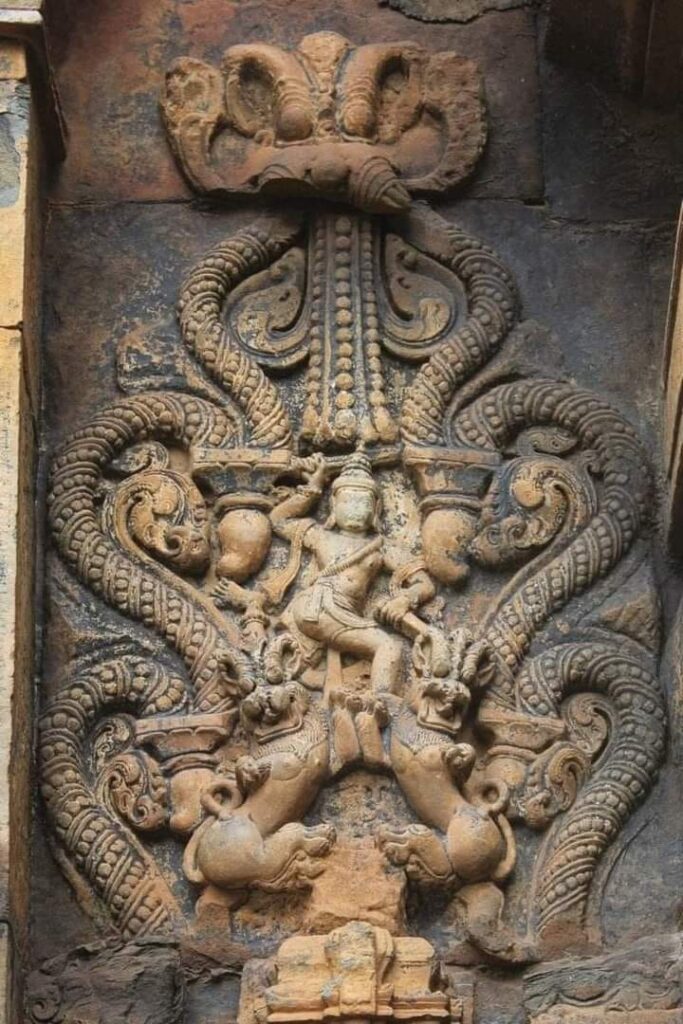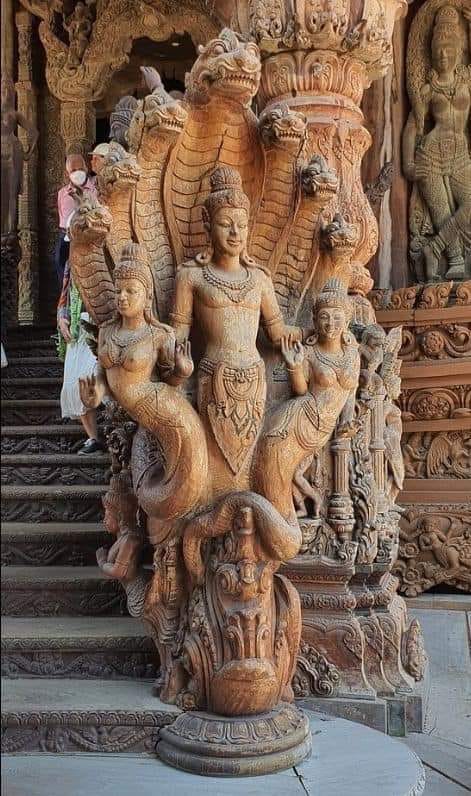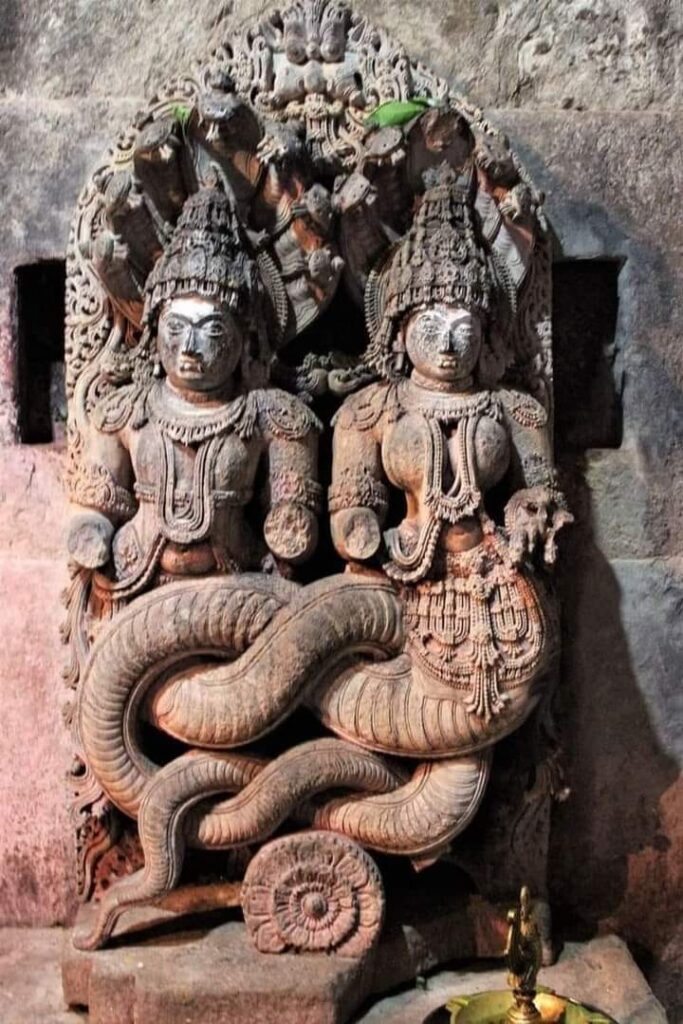
According to the Hindu calendar, Naga Pañcami falls on the fifth day of the bright fortnight of the lunar day in the month of Shravan.
The festival derives its name from the combination of two words - nag, which means cobra/serpent, and panchami, which is the fifth day after the new moon or Shukla Paksha in the month of Shravana (July/August), according to the Hindu calendar.
Interestingly it is also termed Garuda Pañcami – as Garuda, or the royal eagle is the natural enemy of the Snakes and serpents.

The ancient Indian civilization perceived snakes or Nagas as sacred creatures, so they paid them respect and care. Temples have been erected in their honor; images of snakes carved from stone are often found along roads, reservoirs, and villages.
According to ancient Hindu scriptures, the snake-like Gods – Nagas, taught people to talk and brought writing to the people. And, having received sacred knowledge from the Gods, people actually became “people.” The presence of language and writing separated people from the animal world.
Until now, isolated tribes of people live in India and Indo-china region, who consider their ancestors to be half-snakes, half-people, calling them Nagas. The Nagas believed to be migrated from the Divine realm of Indra can travel through heaven and the mortal realm through a bridge.
According to Indian Mythology, Nagas are highly developed snake-like creatures that can induce a state of hypnosis in people. Creating an illusion, the holographic Nagas appear before people in the form of beautiful women and men. Countless temple images and sculptures of gods and goddesses show creatures with the upper part of a man, the lower part – a snake’s tail, sometimes up to three meters in size.
Half-humans – half-reptiles had a friendly character; they constantly communicated with people.
In the Vedas and myths of Ancient India, Kashyapa Rishi, the grandson of the creator of the world Brahma, is recognized as the progenitor of most living beings. From the three older wives, he had demons – asuras and gods, and the other ten wives gave life to various creatures that inhabited the earth, the heavens, and the underworld.
Surasa gave birth to huge monstrous dragons, Arishta became the progenitor of crows and owls, hawks and kites, parrots and other birds, Vinata gave birth to giant sunbirds Aruna and Garuda, Surabhi – cows and horses, and many more divine and demonic creatures descended from other wives of Kashyapa. Kadru became the mother of the Nagas, and Muni -became the mother of the crafty geniuses of the Gandharvas, who settled in heaven along with the ” nymphs ” – Apsaras.
Nagas settled in the underworld of Patala, where they erected for themselves splendid palaces glittering with gold and precious stones.
The wise serpent Vasuki became the king of the Nagas and ruled in their underground city of Bhogavati, full of treasures unseen on earth. Some of the Nagas settled in underground waters, in rivers, and at the bottom of the ocean, in the kingdom of the God Varuna.
Snakes also live on the earth’s surface, where they guard treasures. Royal snakes, three-headed, seven-headed, and ten-headed, own untold riches; their heads are crowned with precious crowns; they are powerful and wise; leaders of the great Naga tribe won the favor and friendship of the gods.
In the 8th Ashtaka of the Rig Veda, It is mentioned about Sarpa-Rajni or “the queen of the serpents or the queen of all that moves.” The Yajur-Veda provides a more definite account of serpent worship; the Samhita of this Veda contains prayers to the Sarpas(snakes) who are addressed as denizens of the heavens, the skies, the rays of the sun, the waters, the vegetables, and the like.
In the Brahmanas of the Samhita part of the Yajur-Veda, invocations are addressed to serpents, and sweet sacrifices are offered for their acceptance.
Manu, the ancient law-giver of the Hindus, also mentions the Nagas and the Sarpas (Snakes). Carved or painted figures of snakes can be found on the walls of many Hindu temples that exist from the medieval era. Images of snake worship rituals can also be spotted in the world-famous Ajanta caves.
A detailed description of the cobra snakes can also be discerned in Arthasastra, the classic ancient Hindu political text by the great Hindu philosopher Chanakya.

In the Bhagavata Purana, Vasuki and eleven other Nagas are mentioned as forming the string of the sun god Surya’s chariot, one serpent being held to be sacred to each month. The Markandeya Purana embodies the well-known story of the marriage of Madalasa, a Naga princess, with King Kulvalasva. Lord Krishna tells Arjuna that Vasuki and Ananta represent him amongst the Sarpas and the Nagas, respectively.
Naga Panchami is observed in the month of Shravana (July/August), the arrival of the rainy season in many parts of South Asia. It is when snakes leave their holes in the flooded fields and jungles and enter the habitations of men – thereby throwing them into great alarm. During this period, the greatest number of deaths from snakebite occur.
The people of the countryside labor under the impression that the only way of obtaining immunity from a snakebite is by propitiating the snake-goddess Manasa. This fear seems to be one of the reasons to celebrate the Naga deity. Appeasing the snake god provides psychological relief to the poor rural folk whose main occupation is agriculture.
According to certain beliefs, ancestors take the form of snakes on this day, due to which it is a widely celebrated festival. Some fast one day before Naga Panchami which is called Naga Chaturthi or Nagul Chavithi
In Christianity snakes are considered to be evil but in India they are considered to be divine. Almost all the main Hindu deities have a snake attached to them. Shiva wears a snake garland and allows them to crawl all over him. Vishnu sleeps on a snake, Ganesha wears a snake belt, Kartikeya has a snake beneath his foot and so on.
Hindus venerate snakes because they represent eternity as well as impermanence, life as well as death, time and timelessness. A snake represents the three processes of the world- creation, preservation and resurrection. It is fascinating to watch a snake changing its skin. It’s quite a laborious and perhaps painful process. This is a lesson to us humans that we can overcome our mortality and achieve immortality however slow or painful the process may be.
Our ancient rishis discovered that the poison in a snake’s body is not generated within its body but from the atmosphere outside. The rishis said that a snake is able to inhale poisonous gases in the neighbourhood extending to a few kilometres in circumference. Hence one of the Sanskrit names for a snake is “Vayubhakshakan” which means “the one who eats air”! The snake that is capable of hissing out a lot of air is also capable of inhaling a vast amount of poison from the air which it retains in its poisonous sac to be used to catch its prey and of course to bite unwary and careless humans.
The snake is a very sensitive creature and can sense the slightest change in the atmosphere, because its whole body is in touch with the ground. It has no ears; it is said to be stone-deaf, so its whole body turns into an organ of hearing.
It has such a keen sense of discernment that it can perceive certain higher dimensions which human beings are desperate to know. By worshipping them, the Hindus believe that they will also be able to acquire part of their wisdom.
Nagas are not simply snakes but represent all the transformative electrical forces of the cosmos from the material level to that of pure consciousness.
As modern physics notes, the entire universe and all of space consists of various wormholes through which subtle currents are relentlessly flowing. These currents are all Nagas, snakes or serpents in a metaphorical sense, powers arising out of a hole or moving through a channel. They are all forms of lightning or dynamic energy strikes that have their enlivening power and their danger or poison. We must recognize that we live, breathe, speak and think in and through the serpent forces of the greater cosmos.
The human body is composed of numerous channels from the digestive tract to the respiratory and circulatory systems, to the brain, from gross to subtle levels, through which the prana or vital force flows at various vibratory frequencies as our main stimulating lightning energy that keeps us alive and awake. All these channels within and around us are connected in the vast fabric of life and awareness, of which we ourselves are but a focus, a point or a transmission center.
Some of these serpent forces are hidden and support us in the background like the electro-magnetic energies that sustain the Earth through the force of gravity, or like Vishnu’s serpent Ananta who holds the power of the entire universe in a state of pure potential. This hidden contracted or concentrated state of forces is like that of a coiled serpent. Other forces are manifesting like a moving snake and swirl around us creating colorful force fields in a magical phenomenal display.
One of the most important of these serpent powers is the Kundalini Shakti, the electrical force of higher prana, mantra and awareness. Normally it is latent or coiled in the earth chakra at the base of the spine, with our life energy resting upon its sleeping state. In Yoga Sadhana, the Kundalini awakens and spreads its electrical currents throughout our body and mind extending to the entire universe, propelling us into the infinite.
Nagas as powerful forces contain profound wisdom, which is the highest transformational energy of awareness. There are such Nagas in the Earth or earth currents holding the Earth wisdom and power, creating various sacred sites and nature’s points of power. There are Nagas in the atmosphere or life currents from which all weather patterns arise through the thunder and lightning, clearing the air and renewing all life. There are Nagas in the sky extending from solar, lunar and planetary currents to those of the stars and galaxies – subtle winds and energies of light in an overflowing tapestry reaching beyond time and space.
On Nag Panchami we honour all forms of Nagas from ordinary snakes to Kundalini, to Lord Shiva who is Nageshvara or Ahipati, the Lord of the Serpents, who holds all the electrical forces in existence, both manifest and unmanifest. The transcendent awareness of Shiva alone in its unshakeable stillness, calm and centeredness can master all the cataclysmic energies of the universe, which dance around him like powerful serpents under his control, yet can never touch him.
We must allow the electrical force of the entire universe, its secret currents of pure consciousness and bliss to flow within us like a dance of perpetual lightning. This is the real inner worship of the Nagas. We do this when we recognize our true nature, our inner being, the presence of Shiva, who rules over the vast and intricate ever-changing cosmos from a point of pure unity within the spiritual heart.
There are many temples of snakes in India, one of these is the Nagchandreshwar temple in Ujjain, which is located on the third floor of the famous Mahakal temple of Ujjain.
The special thing about this is that this temple is opened for darshan only on one day of the year, Nag Panchami (Shravan Shukla Panchami). It is believed that Nagraj Takshak himself lives in the temple.
Nagchandreshwar temple has a wonderful idol of the 11th century, in which Shiva-Parvati are sitting on the seat of a snake with its hood spread. It is said that this idol was brought here from Nepal. There is no such idol anywhere in the world except Ujjain.
This is the only temple in the whole world, in which Lord Bholenath is seated on a snake bed instead of Lord Vishnu. In the ancient idol installed in the temple, Shiva is seated on a ten-faced snake bed along with Lord Ganesha and Mother Parvati. Snakes are wrapped around the neck and arms of Shivshambhu.
